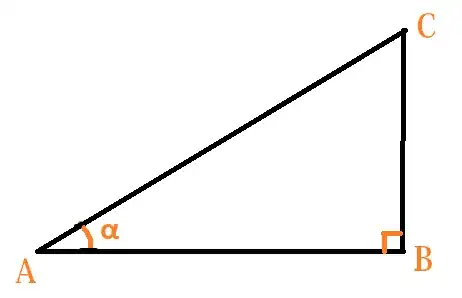I'm currently doing high school second year trigonometry but this is just something that came to my mind.
The figure below shows a right angled triangle $ABC$, where $\angle A = \alpha$, $\angle B = \dfrac{\pi}{2}$ or $90^\circ$.
Now, in introductory trigonometry, the trigonometric functions of an angle are defined as ratios or sides of a right angled triangle. For example : $\sin\alpha = \dfrac{BC}{AC}$.
In the textbook I learned trigonometry from, this were the contents of the first few pages :
The first example was as follows :
You are provided with two triangles. Let those triangles be $XYZ$ and $PQR$. Both of these triangles are right angled triangles. $\angle Y = \angle Q = 90^\circ$. Also, $\angle X = \angle P$. Let these two angles be equal to $\varphi$. Now, $XZ = 5 \text{ units}$, $YZ = 3 \text{ units}$ and $PR = 10 \text{ units}$. Find $QR$.
The solution was as follows : $$\sin\varphi = \dfrac{\text{Perpendicular}}{\text{Hypotenuse}} = \dfrac{3}{5} \text{, obtained from } \Delta XYZ$$ $$\text{From }\Delta PQR \text{, } \sin\varphi = \dfrac{QR}{10}$$ $$\therefore \sin\varphi ~ \dfrac{3}{5} = \dfrac{QR}{10} \implies QR = \dfrac{10 \cdot 3}{5} = 6 \text{ units}$$
I think that prior to this,. the following statement should have been proved :
The trigonometric ratios of an angle are unique and do not depend on the triangle chosen.
I don't think think that this solution would be valid before proving that the sine of $\varphi$ obtained from both the triangles is unique. The statement that I have mentioned above can easily be proved using similarity but what I want to ask in this question is "Should statements like this, which are assumed to be obvious and trivial be proved before attempting questions like the example I gave and would the solution to this example be rendered as invalid if this statement has not been proved beforehand?"
Thank You!

in introductory trigonometry– Rajdeep Sindhu Aug 19 '20 at 06:33